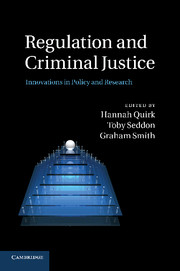Book contents
- Frontmatter
- Contents
- List of figures and tables
- Notes on contributors
- Foreword
- Acknowledgements
- 1 Regulation and criminal justice: exploring the connections and disconnections
- PART I Regulation and criminal justice: framing the debate
- 2 Regulation and its relationship with the criminal justice process
- 3 Reconciling the apparently different goals of criminal justice and regulation: the ‘freedom’ perspective
- 4 On the interface of criminal justice and regulation
- PART II Criminal justice as regulation: responsivity, alternatives and expansion
- PART III Regulation of criminal justice: monitoring, effectiveness and accountability
- Index
- References
3 - Reconciling the apparently different goals of criminal justice and regulation: the ‘freedom’ perspective
Published online by Cambridge University Press: 04 February 2011
- Frontmatter
- Contents
- List of figures and tables
- Notes on contributors
- Foreword
- Acknowledgements
- 1 Regulation and criminal justice: exploring the connections and disconnections
- PART I Regulation and criminal justice: framing the debate
- 2 Regulation and its relationship with the criminal justice process
- 3 Reconciling the apparently different goals of criminal justice and regulation: the ‘freedom’ perspective
- 4 On the interface of criminal justice and regulation
- PART II Criminal justice as regulation: responsivity, alternatives and expansion
- PART III Regulation of criminal justice: monitoring, effectiveness and accountability
- Index
- References
Summary
Criminal justice and regulation: what do we mean by ‘criminal justice’?
Before looking at the goals of the criminal justice system, I first ask what is meant by ‘criminal justice’. In other words, what are the structures and processes with which this chapter will deal? The purpose of a definition is not to identify an absolute truth, but to further an objective. My objective is to show the value of looking at criminal justice and regulation together, both intellectually and in terms of policy development: to show, in part, how what we conventionally think of as ‘criminal justice’ can learn from ‘regulation’ and vice versa. Thus, I choose to define ‘criminal justice’ in an expansive way: to include many areas that are often thought of as ‘regulatory’, as will become apparent.
Phil Edwards raises the interesting question: is criminal justice a form of regulation, or is regulation a form of criminal justice? The answer, in abstract, is both. At one level, criminal justice is just one way of attempting to regulate our behaviour. The ‘Zwelethemba Model’ discussed by Shearing and Froestad (Chapter 5, this book) is a good example, showing how regulatory systems can, and often do, incorporate criminal justice as just one (not necessarily dominating) element. From this point of view ‘regulation’ should not be seen as part of criminal justice.
- Type
- Chapter
- Information
- Regulation and Criminal JusticeInnovations in Policy and Research, pp. 42 - 71Publisher: Cambridge University PressPrint publication year: 2010
References
- 2
- Cited by



